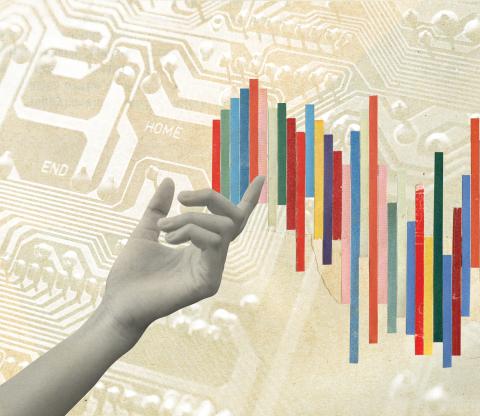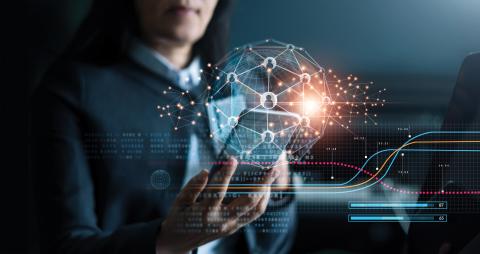Story by Jack Croft
Illustrations by Anthony Gerace
It’s difficult to think of any industry that hasn’t been disrupted by technological advances in recent decades. From financial services to retail to marketing and communications to lodging to supply chain—the list goes on and on.
Most of the significant changes have been driven by the rise of big data and artificial intelligence‚ or as Beibei Dong, associate professor of marketing at Lehigh‚ calls them‚ “the twins‚ because the two often come hand in hand.”
Scientists‚ computer programmers‚ inventors‚ traders and others who are benefiting from the exponential growth of big data and AI would argue that this growth represents an amazing technological achievement. And it is.
But Michael Gusmano, director of the Center for Ethics at Lehigh‚ believes, however, there are other things to consider regarding any new technological advancement.
“Technology is neutral‚” Gusmano says. “But the uses of technology are never neutral.”
Beibei Dong agrees that almost any new technology comes with both benefits and harms—depending on how the technology is used. Big data‚ Dong says‚ has three primary characteristics‚ which she calls the Three Vs: Variety‚ Volume and Velocity. Each characteristic can contribute to both positive and negative impacts on business.
Variety isn’t always the spice of life
The variety of data that companies collect from consumers every day is enormous‚ whether offline when something in a retail store is purchased (of course‚ no one is offline when purchasing because our phones track our movements)‚ or online—from e-commerce shopping to browsing history‚ search his- tory‚ and‚ of course‚ social media data.
“We can see that‚ these days‚ companies are able to capture almost every movement of the consumer online and offline‚” Dong says.
On the plus side, ‚ AI and big data make it possible for marketers to target consumers with information and offerings that‚ at least in theory‚ they’re interested in.
“With the data they have collected‚ marketers probably know you better than your parents‚ even better than you know yourself‚ because they have created a digital profile about you that captures everything‚” Dong says. “With this powerful tool‚ marketers can truly provide the most personalized and relevant products‚ services‚ promotions and advertisements to customers.”
However‚ the tradeoff is a significant loss of privacy. “Sometimes‚ we are not even aware when the technology is spying on us‚ so this makes us nervous‚” Dong says. “Most of the time‚ the privacy concern is not because companies use our data illegally or truly harm us in some way. It’s the fact that we don’t know how companies have collected the data and how they will use the data. It’s the uncertainty and lack of transparency that concern users the most.”
Oliver Yao, the associate dean for graduate programs‚ who holds the George N. Beckwith ’32 Professorship in decision and technology analytics‚ agrees. “Privacy is one of the largest concerns from this technological advancement‚ particularly because of data analytics and data gathering.”
Yao says the move by Apple with its iPhone technology represents an interesting way to address privacy concerns. “Apple gave consumers the power to turn off private information sharing‚” Yao says‚ “so individuals can decide whether they want to block advertisers from tracking their behavior online and off‚ or push ads to them. Though this may create an issue for Facebook or Google‚ it protects consumers on the other end.”
Filter Bubble and Propagating Polarization
The messaging from marketing experts “all sounds very positive‚” Gusmano says. “We’re going to learn about your preferences. We’re going to make sure that you’re getting what you want. And that’s terrific. But when it comes to bigger social issues‚ I think it’s kind of scary.”
That’s because there are “invisible‚ unintended consequences of algorithms that were designed by marketing people to sell people particular products” when they are unleashed on social media‚ Gusmano says. For many people today‚ AI decides what news and political viewpoints are pushed to their social media feeds. The result is increasing numbers of people living inside filter bubbles‚ growing more biased as they lose their ability to think critically.
“We already suffer from what’s called a confirmation bias‚ which means that we’re more likely to believe the facts that fit our pre-existing assumptions about the world and discount any facts that contradict those beliefs‚” Gusmano says. “If you combine that with this sort of effort to drive people only toward arguments and opinions and evidence that are consistent with their pre-existing beliefs‚ then nobody thinks critically‚ which contributes to the kind of polarization we currently see in society.”
Parveen Gupta, who holds the William L. Clayton Distinguished Professorship in Accounting‚ asks: “What is the definition of an intelligent human being? The definition of an intelligent person is the ability to hold contradictory views in your head. And what we are finding as a result of this polarization‚ is that people don’t want to hold contradictory views; rather‚ they prefer to associate with people of the same views.”
Pump up the volume
The volume of data that companies are capturing about people almost every second is staggering.
Kathleen Weiss Hanley, who holds the Bolton-Perella Chair in Lehigh University’s department of finance and is director of the Center for Financial Services‚ says big data continues to be “a huge game changer for the entire financial services industry.
“It reduces barriers to entry‚” she says. “It allows smaller players to get a handhold into markets that they would not normally have been able to infiltrate in the old days. In the past‚ companies needed to hire a lot of people to gain strong footing in an industry; it required huge overhead. Now‚ you don’t need a lot of overhead.
“Many fintech lenders use alternative sources of data in credit scoring‚ so they go beyond the traditional FICO score that a big bank uses‚” Hanley adds. Fintech startups and smaller firms use data to improve their models‚ better predicting default by potential customers‚ so they can price loans better from the start and enjoy higher profits.
Maximum velocity‚ minimal control
Velocity refers to the ability of companies to “capture real-time data‚” Dong says‚ “And that’s very important. That means AI is able to react and provide you with information based on your real-time consumption and behavior.”
For many‚ though‚ the real-time capture of data is what makes a social media site like TikTok potentially addictive.
“TikTok is AI-based. The idea behind TikTok technology is to predict what you like and then constantly push more of what you like within seconds‚” Dong says. “TikTok is powerful in adjusting feeds based on your real-time browsing data to always keep you in the moment.
“Should you be blamed when you just wasted two hours on TikTok? I would say probably not. Thousands of engineers have only one job: to create the best algorithms to push the content you like so you’re hooked. Engineers strive for that level of engagement; that’s how they actually generate revenue. This is a very tough fight.”
Velocity also comes into play with high-frequency trading‚ where every millisecond counts. For much of history‚ trading firms tried to locate their physical offices as close as possible to exchanges so runners could bring back the latest information as quickly as possible‚ Hanley says. Now‚ they co-locate their computers as close as possible to the exchange’s computer services—giving them a digital leg up on many other traders.
That has led to complaints that co-locating near data sources gives some high-frequency trading firms an unfair advantage. IEX (Investors Exchange) even installed a “speed bump”—38 miles of coiled cable that slows the time it takes incoming orders and messages to reach the exchange by 350 microseconds. According to IEX‚ that gives the ex- change “time to take in market data from other venues—which is not delayed—and update prices before executing trades.”
High touch vs. high tech
With all of the advances in big data and AI‚ is there still a place for the human touch?
The impact finance sector—which views extending financial services through a social and environmental justice lens to people who previously lacked access to them—offers one illuminating example.
“The impact finance sector has been built for four decades on close social interactions and presence from officers of financial institutions‚ in the field‚ in rural villages‚ getting to know people who are underserved‚ or not served‚ by traditional banking services‚” says Todd Watkins, professor of economics and director of the Martindale Center for the Study of Private Enterprise at Lehigh.
In the jargon of the impact finance sector‚ Watkins says‚ that approach is known as “high touch.”
“You spend time getting to know people‚ you meet them in their homes or in their villages‚ you get groups of them together to provide financial services to them and groups of people who know each other‚” he says. “There’s information sharing and social dynamics working to provide social capital instead of informational or physical capital that financial institutions have traditionally relied on.”
Watson adds that the move toward fin- tech “has created an interesting tension between high touch and high tech.
“I think it’s inevitable that the sector is going to continue an aggressive movement toward AI and algorithmic financial services and that’s probably really good. Many more people—people who wouldn’t have been served before—will get the services they need. But the tension between the high tech and the high touch and the social dynamic roots of impact finance are seriously at risk if we go too far down the high-tech path.”
Bridging Gaps or Deepening Divides?
In areas where women and people who live in rural areas have lacked access to cell phone and Wi-Fi services‚ as well as the educational opportunities to learn about‚ and understand how to use these technologies‚ the roll-out of tech-based financial services could wind up only benefiting those who already have access to and knowledge of the tech, Watkins warns.
"Gender bias in technology access and technology use is nontrivial and it's a global phenomenon," he says. It happens here, it happens in Kenya, it happens everywhere.
Watkins adds that if the high-touch approach gets lost in the rush to provide technological solutions in areas where existing and persistent gender and social inequities prevail, "You could bridge divides, but you could also just build even deeper divides between the haves and the have nots."
Over the years, Watkins has led groups of Lehigh students to work on projects in Honduras, Cambodia, Ghana, Kenya and India. Even with projects involving high-tech solutions developed by the students, "we mainly focused on the high-touch side of it."
That's because Watkins views high-tech as "a complement to the organizational processes that are already in place: getting to know the clients, interacting with them in their villages, places of work and their homes. There's no substitute for the human touch."
'All of Us'
Virtually every new technology is developed with benefits in mind. However, there are often unforeseen adverse effects that arise from how the technology is used. "In our curriculum, we put a lot of emphasis on educating future business leaders on how to be ethical," Yao says.
Gusmano believes strongly in the positive effect of "infusing conversations with thoughts about ethics and the social implications of technologies early on in business education. I think there are ways to learn how to deal with difficult choices when technology exists. But it would be preferable if you had people developing technology who were routinely reflecting on what the implications might be.”
In addition to those involved in developing technology‚ there are clearly roles for government officials‚ regulators and lawmakers‚ as well as companies and industry leaders.
“Whether we’re talking about geneticists or computer programmers or nuclear scientists‚ they can provide enormous insight into what the ethical consequences are‚” Gusmano says. “But they aren’t the only ones who have important insight and expertise when it comes to examining if and when the benefits of a technology out- weigh the harms.
“That’s all of us‚ right? That’s all of us.”
Emerging Technologies: What’s Next?
When it comes to the next wave of disruptive technologies in business, the past may well be a mere prologue.
“Given current labor disruptions and resultant trends expedited by Covid-19, organizations have been investing in technology that promotes accountability, productivity, and the overall experience of both knowledge and industrial workers, further changing organizational dynamics,” says Joshua Ehrig, professor of practice in management. “This mobility has also demanded more robotics and automation in both business processes and product development, which will have implications for future workforce skill-sets.
“This will only further advance machine-learning capabilities and AI-based applications that will have a fundamental impact on organizations and how they interact, both internally and externally,” he adds.
Kathleen Weiss Hanley, who holds the Bolton-Perella Chair in finance and is director of the Center for Financial Services, believes blockchain technology will continue to have a significant effect in financial services.
“As a ledger, it has some interesting forms,” Hanley says. “Immutability, for example, allows us to share information more broadly without the fear of being hacked. Blockchain technology is quite powerful, and many firms are using it to track transactional and ownership data.”
Ehrig believes “we’ll witness novel and more mainstream blockchain implementations that transcend crypto and NFTs (Non-Fungible Tokens) predicated on virtual assets. More blockchain implementations will translate into more applicable business use-cases, from digital identity, intellectual property and hard assets to various business process applications that will result in business disintermediation.”
How Big Is Big Data?
The explosion in the amount of data being created is mind-boggling—how much data is captured or replicated in traditional and cloud data centers, enterprise-hardened infrastructure like cell towers and branch offices, and PCs, smartphones, and Internet of Things devices around the world. In fact, calling it “big data” hardly seems to do it justice.
A 2018 white paper by IDC, a global provider of market intelligence, advisory services, and events for the information technology, telecommunications, and consumer technology market, predicted that the Global Datasphere would grow from 33 zettabytes in 2018 to 175 ZB by 2025.
To offer some frame of reference, a zettabyte is a measure of storage capacity that is equal to 1 trillion gigabytes. What does 175 zettabytes look like? According to IDC: “If you were able to store the entire Global Datasphere on DVDs, then you would have a stack of DVDs that could get you to the moon 23 times or circle Earth 222 times.”
Global Datasphere Growth
in zettabytes (ZB)
33 ZB
in 2018
-TO-
175 ZB
in 2025
How Big is 1 ZB?
1‚000‚000‚000‚000 GB
(Source: IDC)




